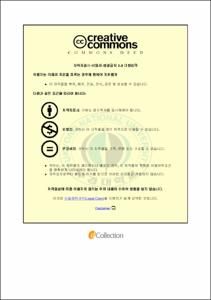수열합성법에 의해 금속이 도핑된 바나듐 산화물 제조와 열 변색 특성
- Abstract
- Pure VO2(M) was synthesized via the reduction of V2O5 by oxalic acid during two-step hydrothermal method and calcination. First, metastable VO2 crystal phase(VO2(A)) was formed at 200 ℃ for 10 h in autoclave. By further increasing calcination temperature to about 700 ℃ for 2 h with N2 gas during calcination step, VO2(A) was transformed perfectly to VO2(M). Due to the small band gap between VO2(A) and rutile-type VO2(M) would directly be transferred to stable VO2(M). The metal-insulator transition (MIT) in VO2(M) starts around 68 ℃. To apply VO2(M) into smart window, phase-transition temperature should be under 68 ℃. We used a tungsten(=W) as dopant in order to lower critical temperature of thermochromic behavior. We demonstrated two facts; the phase-transition temperature was decreased with the increase of W doping, it has excellent thermochromic property without W doping amount.
Furthermore, we synthesized VO2(M) through diminishing the process. VO2(M), produced by 1-step under high temperature and pressure, was confirmed that its proper temperature is 280 ℃ for the experiment. The crystallinity, optical properties, thermal analysis and morphology of VO2 powder were characterized by XRD, UV-vis-NIR, DSC, SEM and TEM.
- Issued Date
- 2014
- Awarded Date
- 2014. 2
- Type
- Dissertation
- Publisher
- 부경대학교
- Affiliation
- 대학원
- Department
- 대학원 공업화학과
- Advisor
- 박성수
- Table Of Contents
- Contents
Contents.......................................................................................................................ⅰ
List of Tables...........................................................................................................ⅳ
List of Figures..........................................................................................................ⅴ
Abstract.......................................................................................................................ⅶ
제 1 장. 서론..............................................................................................................1
제 2 장. 이론적 배경.................................................................................................4
2-1. 열 변색.................................................................................................................4
2-1-1. 열 차단 유리..............................................................................................4
2-1-2. 열 변색 재료..............................................................................................7
2-1-2-1. 유기 화합물......................................................................................7
2-1-2-2. 무기 화합물.......................................................................................9
2-1-2-3. Polymer Thermochromism..........................................................9
2-1-2-4. Sol-gel Thermochromism..........................................................10
2-2. Vanadium Dioxide..........................................................................................12
2-2-1. VO2의 결정상..........................................................................................12
2-2-2. VO2의 열 변색 특성..............................................................................14
2-2-3. VO2의 상전이 특성................................................................................16
2-3. 합성법의 종류..................................................................................................18
2-3-1. 졸-겔법......................................................................................................18
2-3-1-1. 졸-겔법의 원리...............................................................................18
2-3-1-2. 졸-겔법의 장·단점........................................................................19
2-3-2. 공침법........................................................................................................22
2-3-2-1. 공침법의 원리.................................................................................22
2-3-2-2. 공침법의 장·단점..........................................................................22
2-3-3. 스퍼터링법..............................................................................................25
2-3-3-1. 스퍼터링 원리................................................................................25
2-3-3-2. 스퍼터링법의 장·단점..................................................................26
2-3-4. 수열합성법..............................................................................................28
2-3-4-1. 수열합성법의 원리........................................................................28
2-3-4-2. 수열합성법의 장·단점..................................................................28
제 3 장. 실 험..........................................................................................................31
3-1. 시약....................................................................................................................31
3-2. 합성법...............................................................................................................31
3-2-1. 2 단계 합성법........................................................................................31
3-2-2. 1 단계 합성법........................................................................................32
3-2-3. 나노입자 합성법....................................................................................32
3-3. 측정 및 분석...................................................................................................35
3-3-1. XRD 분석................................................................................................35
3-3-2. SEM 분석...............................................................................................35
3-3-3. XPS 분석................................................................................................36
3-3-4. DSC 분석................................................................................................36
3-3-5. TEM 분석...............................................................................................37
3-3-6. UV-Vis-NIR 분석................................................................................37
제 4 장. 결과 및 고찰................................................................................................38
4-1. 결정상 특성.......................................................................................................38
4-2. 모폴로지 특성.................................................................................................39
4-3. 화학적 조성 특성...........................................................................................45
4-4. 열적 특성............................................................................................................45
4-5. 열변색 특성.......................................................................................................51
4-6. 합성법에 따른 효과.......................................................................................54
4-7. 나노입자의 효과.............................................................................................63
제 5 장. 결 론...........................................................................................................67
참 고 문 헌.................................................................................................................69
- Degree
- Master
- Files in This Item:
-
-
Download
 수열합성법에 의해 금속이 도핑된 바나듐 산화물 제조와 열 변색 특성.pdf
기타 데이터 / 2.32 MB / Adobe PDF
수열합성법에 의해 금속이 도핑된 바나듐 산화물 제조와 열 변색 특성.pdf
기타 데이터 / 2.32 MB / Adobe PDF
-
Items in Repository are protected by copyright, with all rights reserved, unless otherwise indicated.